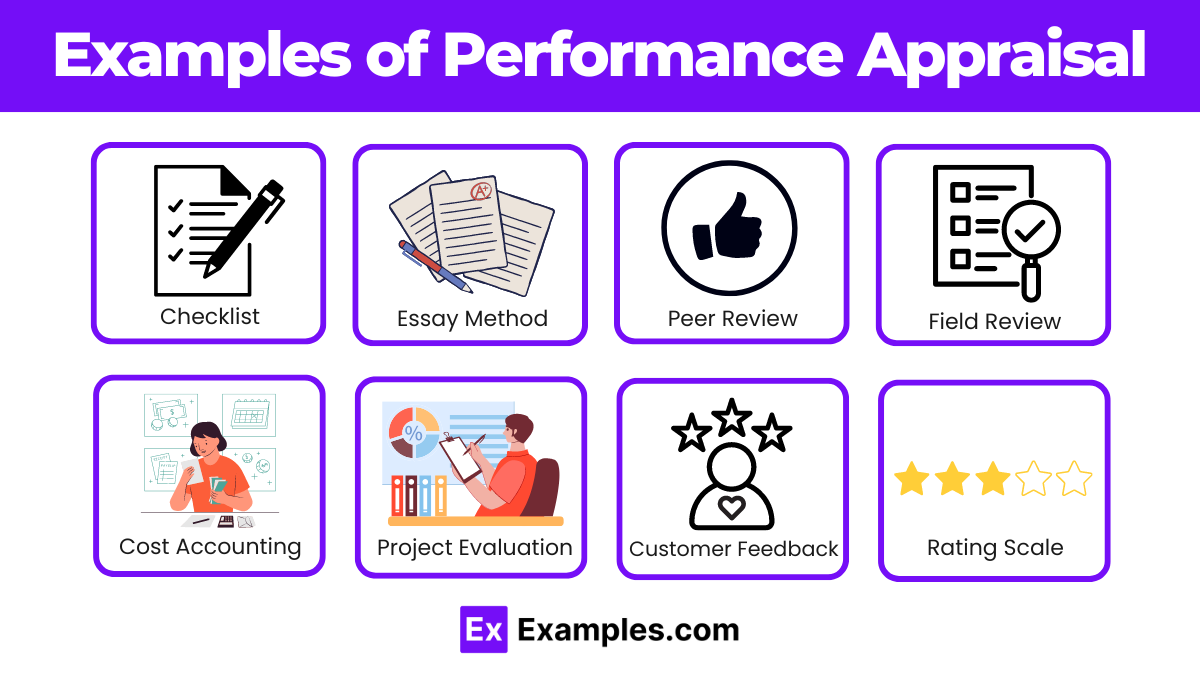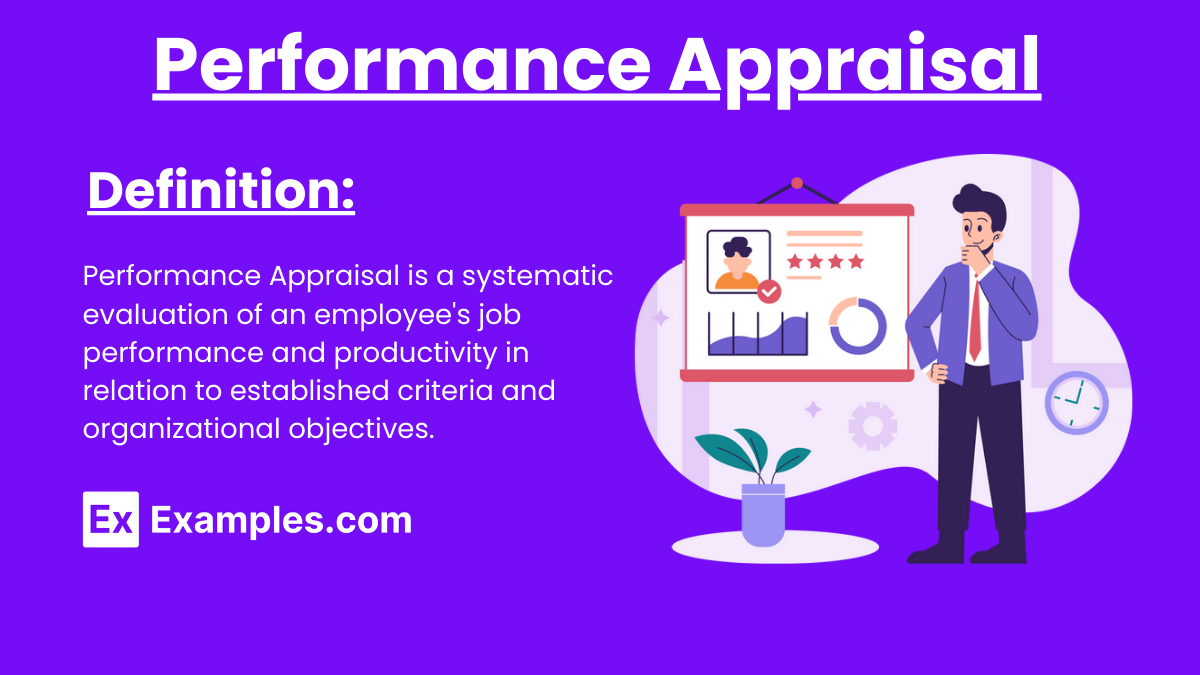20+ Performance Appraisal Examples to Download
Performance appraisal is a systematic evaluation of an employee’s job performance and overall contribution to an organization. It involves the use of tools such as the Performance Worksheet and Performance Report to document and assess various aspects of work. Through an Employee Performance Review, employers can provide constructive feedback and identify areas for improvement. A well-structured Appraisal Policy ensures that the appraisal process is fair, transparent, and aligned with the company’s objectives.
What is Performance Appraisal?
Performance appraisal is the formal assessment and documentation of an employee’s job performance, used to provide feedback, set goals, and guide professional development.
Examples of Performance Appraisal

- 360-Degree Feedback – Collects feedback from an employee’s supervisors, peers, subordinates, and sometimes, customers.
- Self-Appraisal – Employees assess their own performance and progress.
- Management by Objectives (MBO) – Sets specific measurable goals with each employee and then periodically discusses the progress made.
- Rating Scale – Employees are rated on a scale (e.g., 1-5) for various performance criteria.
- Checklist – Uses a list of statements or behaviors that are checked off if applicable to the employee.
- Critical Incident Method – Focuses on specific events or incidents where the employee did something exceptionally well or poorly.
- Behaviorally Anchored Rating Scales (BARS) – Combines elements of the traditional rating scales and critical incidents method.
- Peer Review – Colleagues assess an employee’s performance.
- Assessment Centers – Employees participate in activities such as simulations, role-playing, and exercises to evaluate their competencies.
- Human Resource Accounting Method – Measures the employee’s performance in terms of the monetary benefits they provide to the organization.
- Essay Method – Supervisors write a detailed narrative about an employee’s performance.
- Forced Distribution – Employees are ranked in a bell curve, with a fixed percentage placed in different performance categories.
- Graphic Rating Scale – Uses a graphical scale to rate employees on different criteria.
- Paired Comparison – Employees are compared in pairs to judge which one is better.
- Field Review Method – An HR professional interviews supervisors to discuss and rate the employees’ performance.
- Cost Accounting Method – Compares the cost of retaining an employee to the financial value they bring to the company.
- Project Evaluation Review – Evaluates the performance of employees involved in specific projects.
- Competency-Based Appraisal – Assesses an employee’s performance based on specific competencies required for their role.
- Sales Performance Appraisal – Focuses on sales metrics, targets, and revenue generation.
- Customer Feedback Appraisal – Uses feedback from customers to assess the performance of employees, particularly in customer service roles.
Positive Performance Appraisal Examples
- Quality of Work: John consistently delivers high-quality work that exceeds expectations. His attention to detail and commitment to excellence have significantly improved our project outcomes. His work is always thorough, accurate, and completed on time.
- Productivity: Sarah consistently meets and often exceeds her productivity targets. Her ability to handle multiple projects simultaneously without compromising on quality is commendable. She is a valuable asset to our team.
- Teamwork and Collaboration: Emily is an excellent team player. She collaborates effectively with her colleagues and always offers help when needed.
- Communication Skills: Laura’s communication skills are exemplary. She conveys information clearly and effectively, ensuring everyone on the team is informed and aligned.
- Problem-Solving and Decision-Making: Alex is a highly skilled problem solver. He approaches challenges with a positive attitude and finds effective solutions quickly.
- Dependability and Reliability: Lisa’s reliability is exceptional. She is always punctual, meets deadlines, and delivers consistent results. Her dependability has greatly enhanced our team’s performance.
- Innovation and Creativity: Chris is a highly creative individual who consistently brings innovative ideas to the table. His creative thinking has led to several successful initiatives that have improved our processes and outcomes.
- Leadership and Initiative: Brian shows excellent leadership qualities. He takes initiative, motivates his team, and leads by example. His leadership has been instrumental in achieving our project goals.
- Adaptability and Flexibility: Mark is highly adaptable. He embraces change and is always willing to take on new tasks and responsibilities. His flexibility has been crucial in managing our dynamic work environment.
- Customer Service: David excels in customer service. He addresses customer concerns promptly and effectively, ensuring high levels of satisfaction. His efforts have significantly contributed to our positive customer feedback.
Performance Appraisal for Managers
1. Setting Clear Expectations
Establish specific, measurable, achievable, relevant, and time-bound (SMART) goals. This clarity ensures managers know what is expected of them.
2. Continuous Monitoring and Feedback
Regular check-ins and feedback sessions help managers stay on track and make necessary adjustments. Continuous monitoring can be done through:
- Monthly Performance Reviews: Brief meetings to discuss progress and challenges.
- Quarterly Evaluations: More in-depth assessments to measure goal achievement.
3. 360-Degree Feedback
Gathering feedback from peers, subordinates, and superiors provides a comprehensive view of a manager’s performance. This holistic approach highlights strengths and areas needing improvement.
4. Self-Assessment
Encouraging managers to evaluate their performance promotes self-awareness and personal accountability. This process includes:
- Reflection on Goals: Assessing progress towards meeting objectives.
- Identifying Strengths and Weaknesses: Recognizing areas of excellence and those needing development.
5. Performance Metrics
Utilize quantifiable metrics to evaluate performance, such as:
- Key Performance Indicators (KPIs): Metrics related to team performance, project completion, and financial results.
- Employee Engagement Scores: Assessing the morale and engagement levels of their team.
Self-Appraisal Comments by Employee
Performance
- Quality of Work: “Consistently deliver high-quality work, meeting deadlines and ensuring accuracy. Reduced errors by 20% this year.”
- Productivity: “Increased productivity through efficient time management. Exceeded productivity targets by 15%.”
Achievements
- Project Success: “Led XYZ project, boosting customer satisfaction by 25% and sales by 10%.”
- Professional Growth: “Completed advanced training in [skill], enhancing team contributions.”
Teamwork and Collaboration
- Collaboration: “Work well with team, contributing ideas and support. Improved team morale and productivity.”
- Communication: “Enhanced communication skills, ensuring clear information sharing.”
Areas for Improvement
- Skill Development: “Aim to develop skills in [specific area] through workshops and mentorship.”
- Time Management: “Plan to set realistic deadlines and delegate tasks to maintain workflow.”
Goals for the Future
- Professional Development: “Goal to take on leadership roles and mentor new employees.”
- Performance Goals: “Improve efficiency by 20% and lead two major projects successfully.”
Final Thoughts
Overall Contribution: “Significantly impacted team’s success. Committed to growth and delivering exceptional results.”
Performance Appraisal Methods
- Graphic Rating Scale: Rates employees on job-related factors (e.g., quality of work, punctuality) using a numerical scale.
- 360-Degree Feedback: Collects performance feedback from supervisors, peers, subordinates, and customers for a comprehensive view.
- Management by Objectives (MBO): Sets specific, measurable goals collaboratively, and evaluates performance based on goal achievement.
- Behaviorally Anchored Rating Scales (BARS): Defines specific behaviors for each performance level, using them as anchors on the rating scale.
- Critical Incident Method: Documents specific instances of exceptional or poor performance, reviewed periodically for appraisal.
- Checklist Method: Uses a checklist of traits or behaviors, marked as “yes” or “no” to assess performance.
- Forced Distribution Method: Distributes employees into predefined performance categories (e.g., top 10%, middle 70%).
- Essay Method: Involves writing a detailed narrative about the employee’s performance, allowing in-depth analysis.
- Ranking Method: Ranks employees from best to worst based on their performance, suitable for small teams.
- Paired Comparison Method: Compares each employee with every other employee in pairs, determining the better performer.
- Self-Appraisal: Employees evaluate their performance, encouraging self-reflection and goal setting.
- Human Resource Accounting Method: Measures the cost and contribution of human resources in financial terms.
Performance Appraisal Goals
- Clarifies Expectations: Goals provide clear guidelines on what is expected from employees.
- Enhances Focus: Specific goals help employees concentrate their efforts on key tasks.
- Drives Motivation: Achievable goals motivate employees by providing a sense of purpose and direction.
- Facilitates Development: Goals encourage continuous learning and skill enhancement.
- Aligns Objectives: Aligns individual performance with the overall goals of the organization.
Delivering Performance Appraisal Feedback
- Enhances Employee Development: Feedback highlights areas where employees excel and where they can improve.
- Boosts Motivation: Recognizing achievements can increase an employee’s motivation and engagement.
- Aligns Goals: It ensures that employees’ goals are aligned with the organization’s objectives.
- Improves Performance: Constructive feedback helps Employee Self Appraisal improve their performance and productivity.
Performance Appraisals vs. Performance Management
| Aspect | Performance Appraisals | Performance Management |
|---|---|---|
| Definition | A periodic evaluation of an employee’s performance. | Ongoing process of managing and improving employee performance. |
| Focus | Retrospective; past performance. | Prospective; continuous improvement and future performance. |
| Frequency | Typically annual or semi-annual. | Continuous, throughout the year. |
| Objectives | Evaluate past achievements. | Align employee goals with organizational objectives. |
| Feedback | Often a one-time event during the appraisal meeting. | Continuous and real-time feedback. |
| Goal Setting | May set goals during the appraisal meeting. | Regularly reviewed and updated goals. |
| Involvement | Primarily involves the manager and the employee. | Involves the employee, manager, peers, and sometimes clients. |
| Development Focus | Limited; mainly evaluative. | Strong emphasis on personal and professional development. |
| Documentation | Formal, documented appraisal reports. | Ongoing documentation through regular check-ins and reviews. |
| Training Needs Assessment | Identified during appraisal. | Continuously assessed and addressed. |
| Rewards and Recognition | Often tied to performance appraisals. | Integrated into the continuous management process. |
| Employee Engagement | Can be low due to infrequent feedback. | Typically higher due to regular interaction and feedback. |
| Adaptability | Less adaptable to changes in performance. | Highly adaptable to changes and continuous improvement. |
How often should performance appraisals be conducted?
Typically, appraisals are conducted annually or semi-annually, but frequency can vary based on organizational needs.
What are the main types of performance appraisals?
Types include traditional, self-assessment, 360-degree feedback, MBO, behavioral checklist, critical incident method, graphic rating scale, and essay appraisal.
What is 360-degree feedback?
It gathers performance feedback from peers, subordinates, supervisors, and sometimes customers, providing a comprehensive view.
How do self-assessments benefit employees?
Self-assessments increase self-awareness, engage employees in their development, and promote accountability.
How can behavioral checklists be used in appraisals?
They evaluate specific job-related behaviors, providing a structured and objective assessment method.
How does goal setting improve appraisals?
It provides clear expectations, drives motivation, and aligns individual performance with organizational objectives.
What role does feedback play in appraisals?
Feedback highlights strengths, identifies areas for improvement, and guides future performance and development.
How can employees prepare for performance appraisals?
Employees should review their performance, set personal goals, and be ready to discuss achievements and challenges.
What are common mistakes to avoid in appraisals?
Avoid vague feedback, focusing only on negatives, and not following up on set goals and progress.
How can employees use performance appraisals for career growth?
Employees can identify strengths, address weaknesses, and set career development goals during appraisals.


